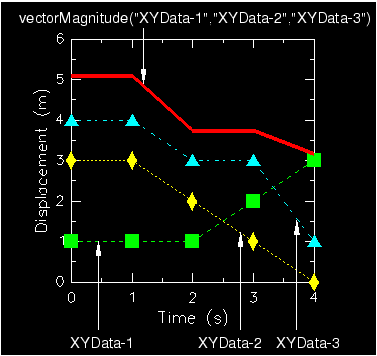Context:
The new X–Y data object has as its X-coordinates all X-coordinates of the first data object and any additional X-coordinates needed for alignment of the remaining objects. Abaqus/CAE computes additional X–Y data pairs by interpolation and extrapolation. The new data object has as its Y-coordinates the square root of the sum of the squares of all input X–Y data object Y-coordinates at matching X-coordinates. The arguments to this function are commutative.
Figure 1 illustrates the type of X–Y plot that can be produced using the function.
Figure 1. X–Y plot produced using the function.

Locate the Operate on XY Data dialog box.
From the main menu bar, select . Click Operate on XY data in the dialog box that appears; then click Continue. The Operate on XY Data dialog box appears.
From the Operators listed, click .
The function appears in the expression window.
From the XY Data choices, click the names of three X–Y data objects on which to operate and click Add to Expression. You can choose from all X–Y data objects previously saved within this session (listed alphabetically in the XY Data field).
The X–Y data object names appear, separated by commas, within the function parentheses in the expression window.
To continue to build your expression, position the cursor in the expression window and type in or select the functions, operators, and X–Y data you want to include.
To evaluate and display your expression, click Plot Expression.
To save your new X–Y data object, click Save As and then provide a name in the dialog box that appears.
Saving your data object makes it available for future operations within this session and for inclusion in X–Y plots containing multiple data objects.
When you are finished, click Cancel to close the dialog box.
